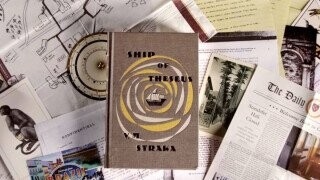J.J. Abrams Best Work Is A Book ... He Didn't Actually Write

Not uncharacteristically, the internet has given J.J. Abrams a lot of crap this week following an interview in which he congenitally admitted that sometimes it's best to "plan things as best you can." Naturally, this touched a nerve for Star Wars fans who were frustrated by the resolution of the sequel trilogy, but also those who felt burned by the haphazard resolution to some of Abrams' most popular TV series. And then there's the veritable wasteland of much-hyped/ultimately canceled Abrams-produced projects. Remember Revolution? Alcatraz? Robotopia? Okay, we made the last one up, but that only proves just how goddamn forgettable most of those shows were.
The point is Abrams has accrued a bad reputation for selling us on mysteries that end with all the satisfaction of a wet fart in a prom dress. But we'd like to take this moment to err on the side of positivity and recommend what is arguably the most successful Abrams-attached product: a 2013 book he co-wrote simply titled S.
While Abrams' famous "mystery box" approach to storytelling has undeniably had its successes, just going by the sheer number of film and TV projects he's been involved with, realistically, it's died on screen more than Sean Bean. But S. gives us a literal manifestation of that analogy; an actual box, inside of which is what appears to be an old library book, complete with aged, yellow paper and an index card.
Don't Miss
The surprises don't end there. Inside the book, there's a whole lot more stuff, including postcards, maps, photos, a decoder wheel, and other documents that you discover as you progress through the book; a fake novel by a fictitious author. Readers pore through not only the text itself but the notes of two collaborators scrawled in the margins as they work to untangle a real-life conspiracy to which the story may hold certain clues.
If that all seems too straightforward, there are multiple sets of notes in different colors of ink, depending on when the characters are writing them, essentially giving the story multiple simultaneous timelines for you to try and make sense of. But here's the thing: J.J. Abrams didn't actually write this book.
Despite his prominent billing, as Abrams himself stated, all he did was come up with the "book-within-a-book concept." The actual writing was done by the credited co-writer, an author named Doug Dorst. Because Dorst was a relative unknown, and the book deals with authorship conspiracy theories, fans immediately speculated that there was no such person and it was all "a hoax perpetrated by J.J." -- which kind of sucks for the guy seeing as he did all of the work.
While the book was well-reviewed, it quite didn't crack the zeitgeist, perhaps in part because of the confusing marketing campaign which announced the project with a faux arty black and white short film that A) didn't give people a sense of what the tone of the book really was, and B) didn't actually mention that it was for a book at all, leaving head-scratching fans to surmise that it was probably for some new movie or video game.
So while a lot of us may be fed up and annoyed at J.J. Abrams when weighing his contributions to pop culture, perhaps this book that bears his name should at least be in the conversation. It's everything one would want from the kind of mystery Abrams repeatedly hocks -- but with an actual ending, which, while still open to interpretation, doesn't string you along with the promise of some hypothetical, answer-filled sequel. It's the Abrams ethos made manifest in a package that feels complete, satisfying, and in no way features any surprise appearances by elderly wizard clones.
You (yes, you) should follow JM on Twitter! And check out the podcast Rewatchability.
Top Image: Mulholland Books